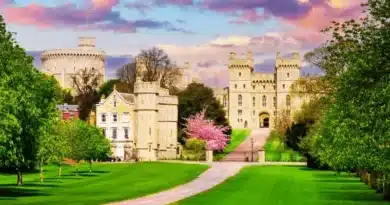Get to Windsor Castle From Sheffield
Key Points
- Windsor Castle is approximately 170 miles (274 km) from Sheffield. The best way to get to Windsor Castle from Sheffield is by train, offering a balance of speed and convenience.
- The fastest route takes around 3 hours and 6 minutes, involving a train from Sheffield to London St Pancras, a transfer to Farringdon for the Elizabeth Line to Slough, and a short 6-minute train ride to Windsor & Eton Central.
- Driving is an alternative, taking approximately 3 hours 30 minutes via the M1, M25, and M4, but traffic congestion, especially near London, can increase journey time.
- Cycling is feasible but challenging, requiring at least 16 hours of continuous riding over 178–190 miles.
Routes Comparison Table
| Mode of Transport | Route | Distance | Estimated Time | Transfers | Key Considerations |
|---|---|---|---|---|---|
| Car | Via M1, M25, M4 | ~170 miles | ~3 hours 30 minutes | None | Fastest and most direct option, may encounter traffic congestion. |
| Train | Sheffield → St Pancras → Paddington → Slough → Windsor & Eton Central | Varies | ~3 hours 6 minutes | 3 (London St Pancras, Paddington, Slough) | Fastest train route, minimal waiting times. |
| Train | Sheffield → St Pancras → Farringdon → Elizabeth Line → Slough → Windsor & Eton Central | Varies | ~3 hours 39 minutes | 3 (London St Pancras, Farringdon, Slough) | More transfers, but can be efficient if connections are well-timed. |
| Train | Sheffield → Wakefield Westgate → London Kings Cross → Paddington → Slough → Windsor & Eton Central | Varies | ~4 hours 2 minutes | 4 (Wakefield, Kings Cross, Paddington, Slough) | Longest train route, more seating availability. |
| Train & Bus | Sheffield → St Pancras → Paddington → Slough → Windsor by Bus | Varies | ~3 hours 46 minutes | 3 (London St Pancras, Paddington, Slough) + bus | Train to Slough, then bus instead of final train. |
| Cycle | Via National Cycle Route 6 | ~182 miles | ~16 hours 10 minutes | None | Requires physical endurance, some restricted paths. |
| Cycle | Via National Route 52 & NCR 6 | ~190 miles | ~16 hours 50 minutes | None | Longer but slightly less steep climbs. |
| Cycle | Via A60 & NCR 6 | ~178 miles | ~16 hours 1 minute | None | Shortest cycle route but most elevation gain. |
Getting to Windsor Castle from Sheffield by Car
Travelling from Sheffield to Windsor Castle by car is a straightforward journey that covers approximately 170 miles and takes around 3 hours and 30 minutes under ideal conditions. The fastest route currently avoids congestion on the A630 and primarily follows the M1 motorway. Below is a step-by-step guide to reaching your destination efficiently.
Route via M1
1. Departing from Sheffield
Begin your journey in Sheffield and follow these directions to join the M1:
- Head northwest on Leopold Street toward Orchard Lane and proceed through one roundabout (0.1 mi).
- Continue onto Pinfold Street (289 ft).
- Continue onto Trippet Lane (0.1 mi).
- Turn left onto Rockingham Street (259 ft).
- Turn right onto West Street (266 ft).
- Turn left onto Westfield Terrace (404 ft).
- Continue onto Trafalgar Street (0.2 mi).
- Turn right onto Milton Street (472 ft).
- Turn left onto Fitzwilliam Street (404 ft).
- Turn right onto Moore Street (0.2 mi).
- At the roundabout, take the 1st exit onto St Mary’s Gate (0.2 mi).
- At Bramall Lane Roundabout, take the 2nd exit onto St Mary’s Road/A61 (0.2 mi).
- Slight left onto Shoreham Street/A61 and continue straight (0.4 mi).
- Take the 4th exit onto Sheffield Parkway/A61 at Park Square Roundabout and follow it (2.9 mi).
- Take the B6200 exit (0.2 mi).
- Take the 3rd exit onto Handsworth Road/B6200 at the roundabout and follow it (2.8 mi).
- At the roundabout, take the 2nd exit onto Aston Way/B6200 (1.0 mi).
- At the roundabout, take the 2nd exit onto Aston Bypass/A57 (1.0 mi).
- Take the 1st exit at the roundabout and stay on Aston Bypass/A57 (1.0 mi).
- At the roundabout, take the 3rd exit onto the M1 ramp to London South (0.5 mi).
2. Following the M1 to Slough
Once on the M1, continue the main portion of the journey:
- Merge onto the M1 (57.3 mi).
- Keep right to stay on the M1 (75.9 mi).
- At Junction 6A, use the 3rd lane from the left to take the M25 exit toward M40/M4/Heathrow Airport (0.8 mi).
- Use the right lane to take the ramp onto M25 (18.8 mi).
- At Junction 15, use the left two lanes to merge onto the M4 towards Slough (2.2 mi).
- Take the A4 exit toward Colnbrook/B470/Datchet/Langley (0.3 mi).
3. Final Leg to Windsor Castle
To complete your journey to Windsor Castle, follow these directions:
- At Langley Roundabout, take the 2nd exit onto Major’s Farm Road/B470 (1.7 mi).
- Take the 2nd exit onto London Road/B376/B470 (210 ft) at the roundabout.
- At the roundabout, take the 1st exit onto High Street/B470 (0.2 mi).
- Turn right onto Windsor Road/B470 (1.4 mi).
- Turn left onto Thames Street/B3022 (Note: This road may be closed at certain times or on certain days) (0.2 mi).
- Turn left onto Castle Hill (266 ft).
Arrival at Windsor Castle

You have now arrived at Windsor Castle, one of the most iconic landmarks in the United Kingdom. Ensure to check parking options in advance, as areas around the castle can be busy, especially during peak hours.
By following this detailed route, you can enjoy a smooth and efficient drive from Sheffield to Windsor Castle while minimising congestion along the way.
Getting to Windsor Castle from Sheffield by Train
Travelling from Sheffield to Windsor Castle by train involves multiple transfers, varying travel times, and different modes of transport, including walking and bus connections. The journey can take anywhere between approximately 3 hours 6 minutes, and 4 hours 2 minutes, depending on the chosen route, transfer times, and waiting periods between connections.
Factors Affecting Travel Time
- Number of Transfers
- All routes require at least two or more train changes, typically involving major stations like St Pancras International, Farringdon, Paddington, or Slough.
- Some routes also require a bus transfer towards the journey’s end, adding to travel time.
- Waiting Times Between Transfers
- Shorter journeys have minimal waiting times between trains, while longer journeys involve extended wait periods at transfer stations.
- For instance, routes passing through Paddington tend to have longer waits compared to those using the Elizabeth Line from Farringdon.
- Choice of Train Services
- Faster services: Some routes use direct or express services with fewer stops, such as taking an express train from Sheffield to London before transferring to the Elizabeth Line or GWR service to Slough and Windsor.
- Slower services: Routes involving suburban trains or additional subway connections (such as via the Hammersmith & City Line or Circle Line) tend to be slower due to more stops and potential delays.
- Bus vs. Train for the Final Leg
- Some routes use a direct train from Slough to Windsor & Eton Central, taking approximately 6 minutes.
- Other routes rely on a bus connection from Slough, which can take about 16 minutes, depending on traffic and stop intervals.
Summary of Travel Times
- Fastest Route: Approximately 3 hours 6 minutes (involves minimal transfers and efficient connections via St Pancras and Paddington).
- Typical Routes: Most journeys range between 3 hours 39 minutes and 3 hours 46 minutes, depending on waiting times and whether a bus or train is taken from Slough.
- Longest Route: Around 4 hours 2 minutes, involving a transfer at Wakefield Westgate, followed by an LNER service to London before continuing towards Windsor.
Travellers should consider their preferred level of convenience versus speed when selecting a route. The quickest journeys involve fewer changes and shorter wait times, while longer ones may offer better seating availability or flexibility in train choices. Opting for train-only routes over bus connections can slightly reduce variability in travel duration.
Getting to Windsor Castle From Sheffield By Cycle
Cycling from Sheffield to Windsor Castle is a substantial journey, covering approximately 178 to 190 miles (286 to 306 kilometres) and requiring an estimated 16 to 17 hours of continuous riding. The route primarily follows National Cycle Route 6, with variations incorporating National Route 52 and the A60.
Route Options:
- Via National Cycle Route 6:
- Distance: 182 miles (293 km)
- Estimated Time: 16 hours 10 minutes
- Elevation Gain: 4,222 feet (1,287 metres)
- Elevation Loss: 4,377 feet (1,334 metres)
- Elevation Range: 633 feet (193 metres) to 164 feet (50 metres)
- Note: This route includes sections with restricted usage or private roads.
- Via National Route 52 and National Cycle Route 6:
- Distance: 190 miles (306 km)
- Estimated Time: 16 hours 50 minutes
- Elevation Gain: 3,543 feet (1,080 metres)
- Elevation Loss: 3,698 feet (1,127 metres)
- Elevation Range: 633 feet (193 metres) to 52 feet (16 metres)
- Note: This route includes sections with restricted usage or private roads.
- Via A60 and National Cycle Route 6:
- Distance: 178 miles (286 km)
- Estimated Time: 16 hours 1 minute
- Elevation Gain: 5,476 feet (1,669 metres)
- Elevation Loss: 5,630 feet (1,716 metres)
- Elevation Range: 646 feet (197 metres) to 30 feet (9 metres)
Important Considerations:
- Route Restrictions: Some paths may have restricted access or traverse private property. It’s essential to verify access permissions and seek alternatives where necessary.
- Elevation Changes: Be prepared for significant elevation variations, particularly on the A60 and National Cycle Route 6 option, which presents the most substantial climbs and descents.
- National Cycle Network: The National Cycle Network offers a series of traffic-free paths and quiet on-road routes across the UK. National Cycle Route 6 connects Windsor to the Lake District, passing through cities like Luton, Milton Keynes, Northampton, Derby, Nottingham, Sheffield, Manchester, and Preston.
- Windsor Great Park: As you approach Windsor, consider incorporating National Route 4, also known as the Thames Valley Cycle Route, which passes through Windsor Great Park. This scenic path loosely follows the River Thames and provides a picturesque entry into Windsor.
- Planning Resources: Utilise tools like the Cycling UK Journey Planner to map out your route, identify rest stops, and ensure access to necessary amenities along the way.
Embarking on this cycling journey requires thorough preparation, physical endurance, and careful planning. Ensure your bicycle is in optimal condition, plan for adequate rest stops, and stay informed about current route conditions and any potential closures.
Conclusion
Travelling from Sheffield to Windsor Castle offers multiple options, each with its own advantages. The fastest and most convenient method is by train, taking approximately 3 hours 6 minutes with minimal transfers. Driving provides flexibility but can take longer due to potential congestion, while cycling is a challenging but scenic alternative for experienced riders. Each mode of transport requires careful planning to ensure a smooth journey, whether prioritising speed, comfort, or adventure. Ultimately, the best option depends on individual preferences, travel priorities, and available time.









